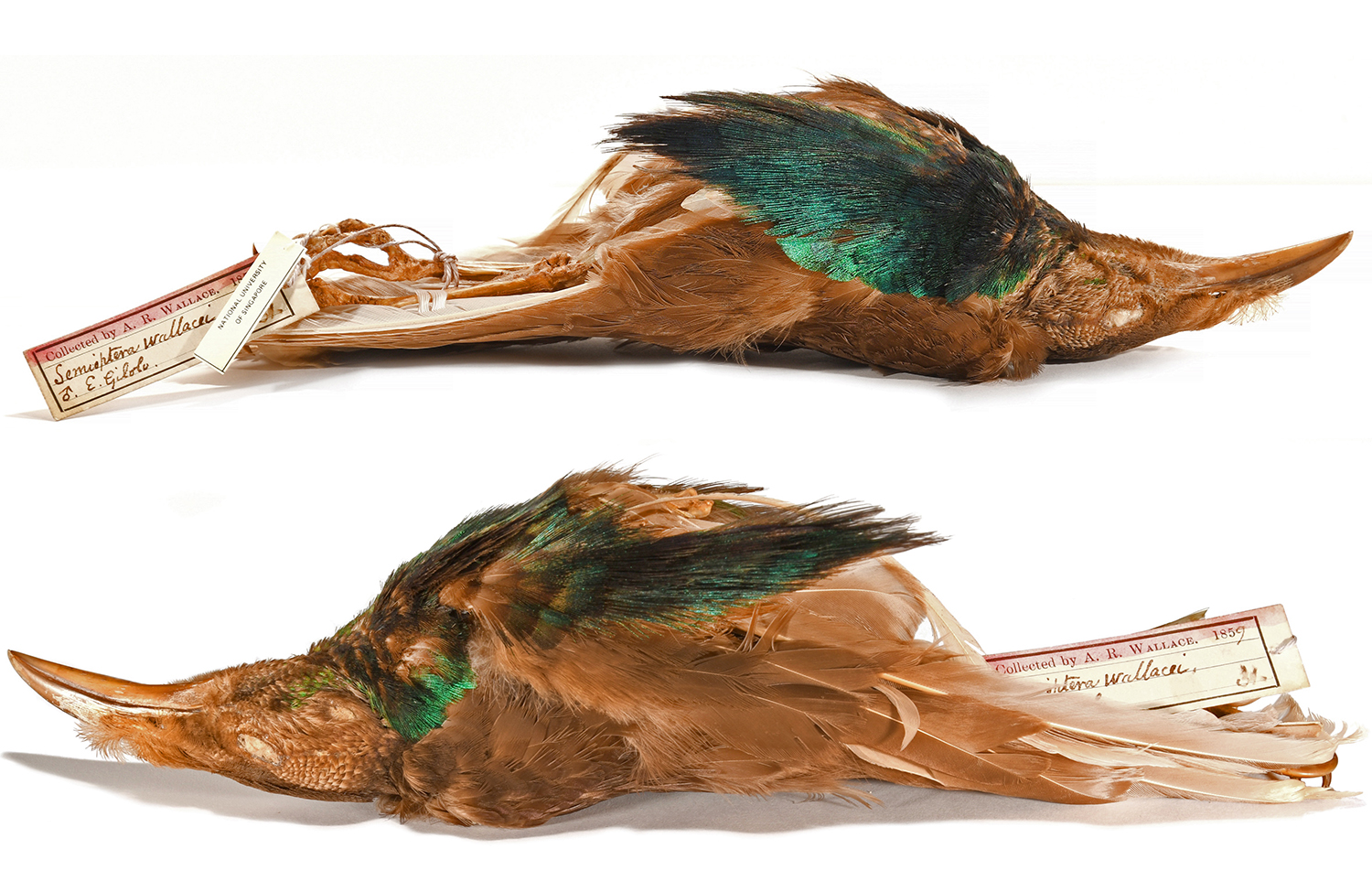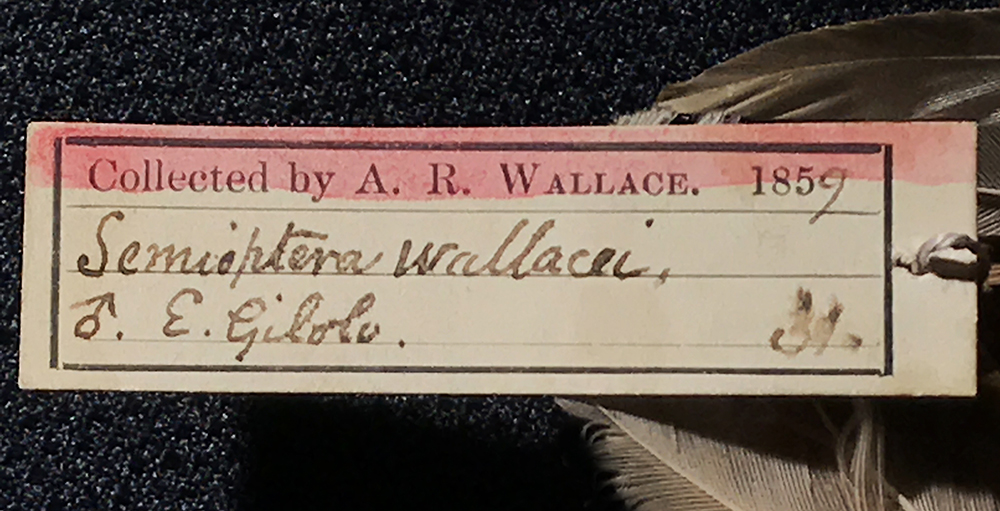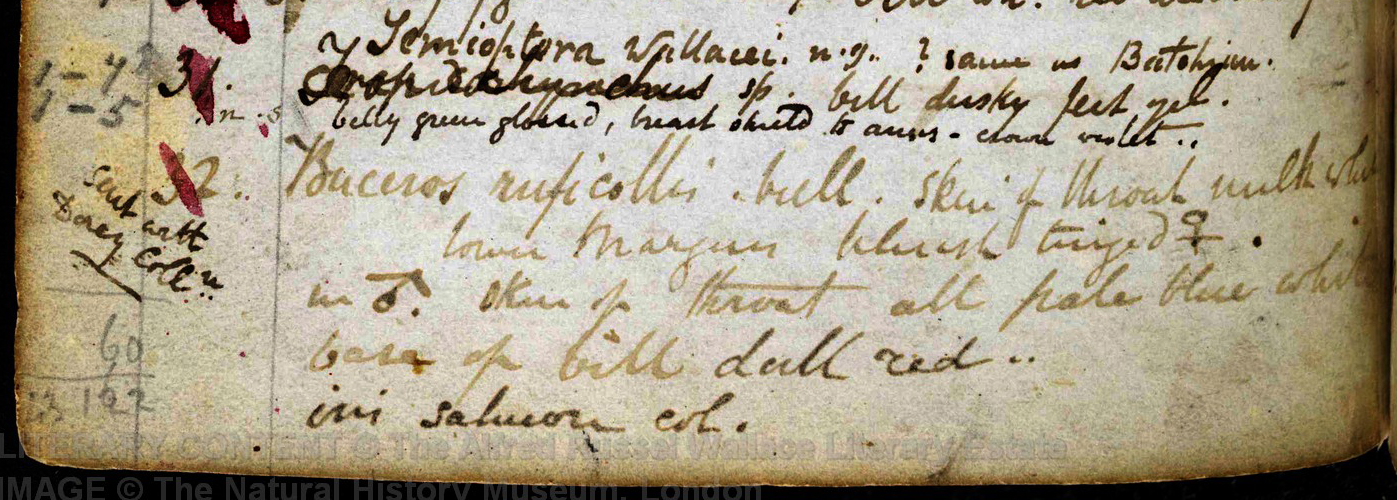By George Beccaloni, August 2019
In December 2017 while preparing a talk about the Birds of Paradise that Alfred Russel Wallace collected in the 'Malay Archipelago' (Singapore, Malaysia, Indonesia and East Timor) during his 1854 - 1862 expedition to the region, I did a Google search for information about Wallace’s Standardwing Bird of Paradise. To my surprise I saw that a UK dealer in Victorian taxidermy specimens had an old museum study skin of this species for sale, and amazingly, it was one which Wallace's assistants had collected for him in East Gilolo (now Halmahera Island) in 1859. Even better, I saw from the red stripe across the top of Wallace's label on the skin, that it was a specimen from his private collection, not one he had been planning to sell through Samuel Stevens, his natural history agent in London.

The Standardwing specimen. Copyright Ruzaini Bin Ghazali / LKCNHM.

The specimen's label. Copyright Frankie Fuller.
I knew that this was something very special, as to my knowledge no Wallace bird specimens had been offered for sale on the open market for very many decades. Not only that, but this was a specimen of probably the most iconic animal species that Wallace discovered during his whole collecting career. I contacted the dealer for more information and he told me that he had bought it as part of an old collection from a French Chateaux, but that he didn't know anything about its history. I asked him to reserve it for me for a few days so I could ask my friend and fellow Wallace aficionado, Prof. Peter Ng, Director of Singapore's Lee Kong Chian Natural History Museum, whether his museum might be interested in purchasing it. I thought it would be fitting for such a specimen to go to a museum in the 'Malay Archipelago' given that most of the c. 126,000 animal specimens which Wallace and his assistants collected in the region are in UK museums. The only Wallace specimens in museums there are a dung beetle in the Sarawak Museum and a small flycatcher in the Singapore Museum, which wasn't even collected by Wallace or his team. Fortunately, Peter was enthusiastic and after much paperwork, the specimen was purchased and exported and is now part of the Lee Kong Chian Natural History Museum's collection.
The discovery of Wallace's Standardwing
 In October 1858, Wallace and his assistant Ali were collecting specimens on the island of Bacan (which Wallace called Batchian), in what is now Indonesia. In his 1869 book The Malay Archipelago, Wallace recounts how:
In October 1858, Wallace and his assistant Ali were collecting specimens on the island of Bacan (which Wallace called Batchian), in what is now Indonesia. In his 1869 book The Malay Archipelago, Wallace recounts how:
"Just as I got home I overtook Ali returning from shooting with some birds hanging from his belt. He seemed much pleased, and said, 'Look here, sir, what a curious bird,' holding out what at first completely puzzled me. I saw a bird with a mass of splendid green feathers on its breast, elongated into two glittering tufts; but, what I could not understand was a pair of long white feathers, which stuck straight out from each shoulder. Ali assured me that the bird stuck them out this way itself, when fluttering its wings, and that they had remained so without his touching them. I now saw that I had got a great prize, no less than a completely new form of the Bird of Paradise, differing most remarkably from every other known bird."
While Ali thought the bird was interesting because he had never personally seen anything like it before, Wallace with his expert knowledge of the birds of the region, and Birds of Paradise in particular, realised it was new to ornithological science. Wallace wrote excitedly to his agent Stevens:
"...I believe I have already the finest & most wonderful bird in the island. I had a good mind to keep it a secret but I cannot resist telling you, I have got here a new Bird of Paradise!! of a new genus!!! quite unlike any thing yet known, very curious & very handsome!!! When I can get a couple of pairs I will send them overland to see what a new Bird of Paradise will really fetch, - I expect £25 each! Had I seen the bird in Ternate I would never have believed it came from here, so far out of the hitherto supposed region of the Paradiseidae. I consider it the greatest discovery I have yet made..." (Wallace, 1858)
Specimens were soon shipped to the UK and George Gray of the British Museum named it Paradisea (Semioptera) wallacii in Wallace's honour (it is now Semioptera wallacii). It was the one and only new Bird of Paradise species which Wallace was to discover.
History of the Singapore specimen
The label that Wallace put on the male S. wallacii now in the Singapore museum states that it was collected in East Gilolo (Halmahera) in 1859, and we know from Wallace's Journal in London's Linnean Society, that in the second half of that year he sent Ali and another paid assistant to collect birds there. The "31" written by Wallace in the bottom right corner of the label corresponds to an entry in one of his collecting notebooks in London's Natural History Museum, which reads "Semioptera Wallacei. n.g. ? same as Batchian." In a letter to Stevens dated 22 October 1859 he says that he was sending specimens from Halmahera of "a Semioptera, which differs a little from the Batchian specimens in the much greater length of the breast plumes and other details." (Wallace, 1860). It is therefore clear that Wallace realised that the Halmahera bird was different from the Bacan one which had been discovered the previous year. It took until 1881 for Salvadori to describe the Halmahera bird as a new subspecies, which he called halmaherae. Shame he did not name it alii in honour of Ali.

The entry in Wallace's collecting notebook.
In the early 1870's Wallace sold most of his private collection of birds to the British Museum, retaining a only small selection, some or all of which he kept until his death in 1913. After he died these were given away or sold by his family. We know that c. 46 specimens were acquired by Mr Parkinson Curtis from Wallace's widow and that they were left to the Dorset County Museum in his Will. We also know that 5 Bird of Paradise skins were sold by Wallace's son to the University Museum of Zoology, Cambridge (Beccaloni, 2019). It is therefore possible that the Singapore museum's Standardwing was acquired after Wallace's death by a French collector, either directly from the family or via one or more intermediaries.
References
Beccaloni, G. W. 2019. Wallace's Collections. The Alfred Russel Wallace Website. <http://wallacefund.info/wallaces-specimens> [accessed 16 August 2019]
Salvadori, T. 1881. Ornitologia della Papuasia e delle Molucche. Parte seconda. Passeres. Torino: G. B. Paravia e Co.
Wallace, A. R. 1858. [Letter to Samuel Stevens dated 29 October 1858. WCP1705.1587].
Wallace, A. R. 1860. [Letter dated 22 October 1859, Amboyna]. Ibis, 2(6): 197-199.
